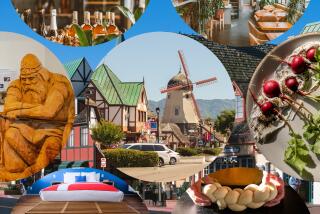STAGE REVIEW : ‘Angels of Swedenborg’ Remains Earthbound
- Share via
Ralph Waldo Emerson called him “a colossal soul (who) lies vast abroad on his times . . . and requires a long focal distance to be seen.” Jorge Luis Borges claimed that “he would see/That which earthly eyes do not see:/The fierce geometry, the crystal/Labyrinth of God and the sordid/Milling of infernal delights.”
So enormous was the scientific and spiritual opus of Emanuel Swedenborg that not even the most exalting of Borgesian verse could exaggerate his visionary work. An 18th-Century Renaissance man, Swedenborg began his career by (among other things) modernizing Sweden’s mining industry, designing an airplane and making breakthrough discoveries in brain research. He culminated his life by writing in breathless detail of his visits to heaven and hell.
Ping Chong, himself a Renaissance man in the 20th Century, has applied his talents in direction, writing, choreography, set design and a dramatic taste for multimedia Weltanschauung to a confrontation with the Swedish colossus in “Angels of Swedenborg,” at Wadsworth Theatre in Westwood.
A meeting of the minds that is not. Chong’s company managed as much grace as possible Wednesday night in a fragmented work that never found a rhythmic or formal foundation to enlighten us in the ways of Swedenborg.
It can be argued that Chong isn’t after enlightenment--although that was at the heart of Swedenborg’s quest. Obscurantism permeates this piece, which is fine in its own way, since the religious philosopher was obscurity incarnate. More troubling are Chong’s bland visual choices and refusal to deal with Swedenborg’s moral dynamic.
Roger Babb, as Swedenborg, at first stands alone on stage, declaring himself in a way that blends the best of the Greeks and post-modernism. We’re in the present day (he has been renamed Robert and owns a Macintosh and two BMWs), and Babb’s troubled persona, drinking massive doses of coffee, suggests a clever but faithful updating of Swedenborg.
Then, through a series of visions triggered by trances, Swedenborg in his stage-right workplace “sees” what we see: a beast frolicking through a pen full of feathers; winged angels in gray dresses moving about one another in very earthbound ways (and to Chong’s very understated movement design); white spirits controlling matters in both the office and in heaven (or is it hell?); a hooded green figure with a synthesized voice that recalls Darth Vader.
That last is a deliberate reference (this green villain is forever tempting an angel with all sorts of sinister and hip asides: “Let’s do lunch. . . . Do you want to do the Watusi?”). And a disorienting one. But to what end? This angel’s wings are literally clipped, and we seem to have witnessed some kind of small triumph of hell over heaven. Swedenborg then joins his angels, which could be tempting fate. But little here recalls Swedenborg’s celestial reports, and Chong often ignores them.
Swedenborg’s afterlife worlds were states of mind, directly rooted in one’s earthly goodness or evil. Heaven is often described in images of hallucinatory ecstasy; hell is Beckett without the humor.
With such theatrical source material, Chong’s choices strike one as only feeble first steps toward a full realization. Some of the music selections (like Popol Vuh’s haunting “Heart of Glass”) are trance-worthy. But from Mel Carpenter’s costumes to Jan Hartley’s slide projections, the watchword is austere. That’s how Swedenborg lived, but not how he saw.
Tonight and Saturday, 8 p.m. Tickets: $20-$24; (213) 825-9261.
More to Read
The biggest entertainment stories
Get our big stories about Hollywood, film, television, music, arts, culture and more right in your inbox as soon as they publish.
You may occasionally receive promotional content from the Los Angeles Times.










